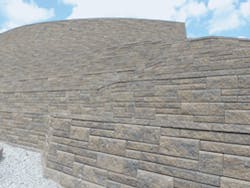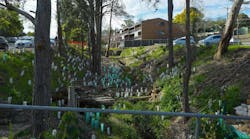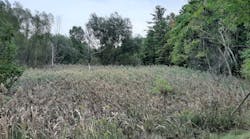Retaining Wall Designs Showcase Slope Stability, Site Aesthetics, and Functionality
Concluding this series on retaining wall design and construction, author Carol Brzozowski profiles two project examples-each with their own planning and construction challenges. While schedules, cost-effectiveness, and construction efficiency are major players in any erosion control project, planners and crew in the implementation of the following projects contend with maintaining proper elevation and wall alignment, multiple soil-types, as well as untimely rainfall as they work toward creating a solid construction slope.
A Gamut of Retaining Walls (Part Four) By Carol Brzozowski
DePauw University
DePauw University in Greencastle, IN, founded in 1837, had put together a master plan to guide development, revitalizing the appearance and function of the campus buildings and grounds. One part of the plan focused on adding quality competition surfaces and constructing a multisport stadium as well as practice fields for soccer, lacrosse, and field hockey.
A new multiuse stadium was built to serve as the southern anchor of the university’s athletic campus. Grade changes around the stadium and practice fields required the placement of several retaining walls.
The walls had to accommodate pedestrian access points as well as blend in with the beauty for which the campus is known; to that end, segmental retaining walls were chosen.
The project team included FA Wilhelm, of Indianapolis, IN, site construction manager/general contractor; TLF Engineers, of Indianapolis; Allan Block producer Reading Rock, of Cincinnati, OH, for the retaining wall; and Atlas Excavating, of West Lafayette, IN.
Reading Rock communicated with Atlas and TLF Engineers for approval of the Allan Block Ashlar pattern walls. Atlas handled the site grading and subcontracted the wall design and construction work.
Allan Block retaining wall blocks dry-stack without mortar or footings. They incorporate a hollow core feature designed to make them easier to handle and promote good drainage behind the wall. A raised lip and notch lock each block in place to create a natural setback. The appearance of hand-laid stone can be achieved by using single-sized blocks or a mix of different block sizes.
Reading Rock worked with local wall builders at Decorative Paving of Loveland, OH, and the engineering firm Civil Design Professionals of Bloomington, MN, to prepare the product bid. University officials selected the Allan Block Ashlar pattern wall, which had come in during the bidding at a lower cost with time savings in the installation process.
Access to the site was regulated and closely monitored because of the presence of the students. An onsite inspector ensured the construction followed the engineer’s specifications.
As the wall contractor, Decorative Paving was challenged by a significant amount of rain before the project’s start. The entire site served as a fill site. The wall was constructed with mostly structural fill. Additionally, the wall construction was being done in conjunction with other site construction activities.
During construction of the multisport stadium, it became apparent there was a significant global stability concern with the site. Decorative Paving worked with Civil Design Professionals and TLF Engineers to revise the plans. The solution was a seven-tiered, terraced wall using select backfill for the infill zones and extended geogrid layers to intercept the global stability slip arcs that were of concern.
The design challenge was that the geogrid layers could not go beyond a line extending at a 1.75:1 slope away from the stadium structure footing for fear of undermining it during construction. That meant a section of wall could not be constructed, because the required cut would leave a slope of less than 1.75:1. The solution for that portion of the wall would be a cast-in-place concrete wall at the bottom of the toe, roughly 4 feet, 6 inches deep and 2 feet wide. The concrete cut wall would intercept the slip arcs that were of concern and ensure that the site remained stable while maintaining a solid construction slope.
Onsite inspections occurred regularly to check compaction, with specifications closely followed. Considerable care was taken to align all of the walls correctly and maintain proper vertical elevations. This proved especially challenging in the vicinity of the cast-in-place concrete stairs. The stairs cut straight through all of the walls, requiring great skill to properly position the leveling pads.
In the end, the crew, led by Jake Taylor at Decorative Paving, constructed an aligned terraced wall structure that also was aesthetically pleasing.
Mulholland Drive
A call came in to Doug Massey, owner of Dakota Drilling & Concrete, from a residential home developer to look at his project’s existing retaining walls. The project, which included the construction of three new custom homes in 2013, was along scenic Mulholland Drive in Calabasas, CA, and the developer wanted an aesthetically pleasing solution. A dozen slopes along Mulholland Drive needed to be shored up in such a way that they would blend in with the natural surroundings.
Massey suggested sculpted soil nail walls, and the developer agreed. Massey provided a solution through Boulderscape, which designs and builds shotcrete wall finishes. The solution provided other benefits as well.
“It minimized excavation, reduced project costs, shortened the construction schedule, and minimized the project’s environmental impact,” says Massey. “The cost savings was passed on to the developer. It minimized any unpleasing construction activities for the scenic route, and it would keep everybody in Calabasas happy.”
In total, some 22,614 square feet of retaining wall was constructed. Dakota Drilling & Concrete crews worked in multiple soil types on the project.
“We’re geared to do any kind of drilling as far as hard or soft, caving or not caving, water or not water,” says Massey. “The access to some of these lots was steep and rough terrain-it wasn’t flatland-type drilling. We used remote-control, excavator-mounted reach drills. We mount a drill mast on the end of an excavator so we can reach up and not have to have benches provided.
“And we’re able to reach down below us on the recessed or inverted-type walls. We do vertical walls and inverted walls. We were able to accommodate the construction of the project logistically by having the versatility to be able to access all of these areas without special benches or roads being made for us.”
Click here for Part One.
Click here for Part Two.
Click here for Part Three.


